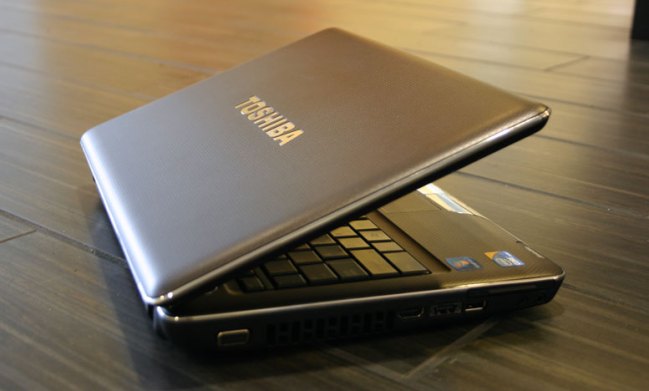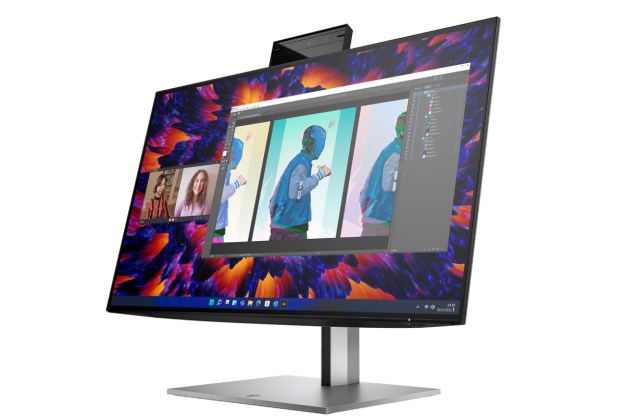“A solid chassis, comfortable keyboard and powerful processor all recommend the U505 series – just stay away from the touch screen models.”
- Powerful Intel Core i5 CPU
- Handles 1080p HD video
- Plentiful ports
- Slot-loading optical drive
- Comfortable LED-lit keyboard and trackpad
- Very poor, dim screen (on touch models)
- Touch screen lacks utility
- Thick and heavy for size class
- Some preinstalled bloatware, nags
- Very little gaming prowess
- Three-hour battery life

Introduction
From cell phones to slate PCs like the Apple iPad, and even all-in-one PCs, touch is all the rage. There’s no denying the intuitive nature of simply tapping a finger on what you want, but can you make any device better simply by slapping a touch screen on it? Toshiba’s U505 S2010 suggests not. The notebook’s fuzzy-looking touch screen – which doesn’t swivel or lie flat like a convertible notebook – provides minimal convenience while significantly degrading screen quality, marring an otherwise well-equipped notebook.
Features
Strip away the touch screen that defines this particular U505-series model, and you have a midrange 13.3-inch machine stacked with a just enough power to separate it from entry-level notebooks whose prime selling point is that they aren’t netbooks. A capable 2.26GHz Intel Core i5 processor drives the machine, joined by 4GB of RAM, and Intel’s rather vanilla GMA HD graphics processor. Toshiba sets its 500GB hard drive apart with motion-sensing drop protection, a feature most commonly found on business notebooks, and spices up its keyboard with LED backlighting. More pedestrian extras include a slot-loading optical drive, decent webcam and a 13.3-inch screen offering up a 1280 x 800 pixel resolution.
 Size and Build Quality
Size and Build Quality
Out of the box, Toshiba’s U505 carries quite a bit more bulk and weight than your average 13-inch notebook. At 1.5 inches thick in the rear (it has a forward-sloping profile) the 4.74-pound U505 snubs the thin-and-light fad that the rest of this size class seems to be going through for a feel that’s downright chunky. Even the MacBook Pro, which we typically consider at the bulky end of the 13.3-inchers, weighs less than the U505 at 4.5 pounds, and measures a whole half inch thinner. (The beefier ordinary MacBook matches it at 4.7 pounds, but still claims a significant size advantage.)
As a side effect to its portliness, the U505 actually feels extremely solid. The plastic trim has little give to it, and feels substantially backed and reinforced compared to some of the flimsy plastic notebooks we’ve seen in the past. If you’re a fan of durability over portability, the U505’s bulk-for-quality trade off might not actually sound like a bad proposition.
Design
Unlike many of Toshiba’s prior, glassy-smooth laptops, the U505 adopts a matte textured finish in one of three shades: Luxe Brown, Luxe Red, and Sweet Pink. The fancy names are a bit much, but as a matter of practicality, this finely imprinted pattern works wonders for reducing fingerprints, mars, scuffs and other side effects of regular handling, and looks pretty clean, too. A line of bright chrome highlights runs around the edges of both the lid and base, but unfortunately, it also spills over onto the left and right trackpad buttons, leaving a mirror finish on one of the most-handled parts of this notebook, which turns into a greasy patchwork of fingerprints in no time.
 Ports
Ports
Although it falls into the compact 13.3-inch size category, the U505 offers no shortage of ports, including both VGA and HDMI video output, a combined eSATA and USB port, two more dedicated USB ports (one on each side), a memory-card reader up front, and of course, an Ethernet jack. Perhaps most impressively for this size, you’ll also get a slot-loading optical drive – a luxury that often gets hacked off in the name of size and money in more compact 13.3-inchers.
 Keyboard and Trackpad
Keyboard and Trackpad
Toshiba’s squared-off keyboard falls somewhere between the trendy Chiclet-style keyboards of a Mac or netbook, and the deep, creviced keys of a conventional keyboard. We like it. The slate-like keys look more modern than the latter, and feel more responsive than the former, making a clean compromise that leaves little to be desired. Toshiba even dodges the gloss black fingerprint syndrome with a duller black finish that our fingers never seemed to be able to leave a trace on. The LED backlighting produces an even glow on all letters, and though some light spills out, the close-cropped keys keep it inside better than on some other LED-backlit notebooks we’ve seen, like Asus’ G51Vx.
Besides the issue with its messy buttons, the trackpad measures up smaller than we would care for on a notebook this size, but redeems itself with some subtle features, too. For one, a soft white LED bar above it looks classy and serves as a discreet visual flag, making it easier to locate the pad in your peripheral vision without taking your eyes of the screen. It also offers an matte finish that’s easy to drag a finger on, and because it’s cleanly flush-mounted with the rest of the palm rest, you can mouse right to the edges without running into any walls. It also supports multi-touch for Mac-like two-fingered scrolling and zooming.
 Touchscreen Display
Touchscreen Display
While the touch screens used on high-end smartphones like Apple’s iPhone and Google’s Nexus One are as transparent as glass, the touch film on the U505 imparts a mottled, grainy-looking texture to the image below, and in the right light, you can actually see the grid of squares that detect touch. Combine this with a screen that visibily lacks brightness – even indoors – and you’re looking at a display you have to tolerate, not appreciate.
If there’s any upside to the lackluster image quality, it’s the touch functionality, which feels precise, smooth and responsive. We were able to do most computing with our fingers quite easily – even making small selections like a folder on the Start menu proved not to be an issue. The real puzzle here remains: Why? Without being able to lay the screen flat as on a convertible tablet – this one won’t even recline past 135 degrees – you’re just making selections with a full keyboard and touchpad at your full disposal, inches away. Touching the screen felt superior for certain browsing tasks, like scrolling and zooming, but the inconvenience of raising your hands to interact with the screen makes it far easier to simply use the multi-touch touchpad for these functions. Frankly, unless you’re completely averse to using a touchpad for mousing, yet demand a full physical keyboard, we find it hard to imagine the type of user who would actually make use of this touch screen after the initial novelty stage.
Performance
The ample RAM and Intel Core i5 processor in Toshiba’s U505 make it capable little performer in and around the desktop. From a cold start, it takes only 49 seconds to reach the desktop and opens a browser window on the desktop in under the one-minute mark. That’s one of the speediest boots we’ve seen from a Windows 7 PC yet. It also feels responsive within the Windows 7 menu system, and handles video all the way up to 720p with aplomb. Full 1080p trailers on YouTube played well enough to actually watch, but lacked the fluid motion you would demand from an actual movie. Apple movie trailers encoded in the H.264 codec played perfectly fine all the way up to 1080p.
Unfortunately, the lack of discrete graphics on this machine will keep gamers away. Without a dedicated ATI or Nvidia graphics card, even 2007’s BioShock left the U505 gasping for air – yet playable with patience – on its lowest settings. You may be able to scrape by with older titles, but for the most part, the lack of a GPU makes it a nonstarter as a gaming box.
PCMark Vantage scores largely reflect the U505’s desktop prowess, netting it an ample 4,781 PCMarks. That far outstrips even many midsize machines like Sony’s Vaio NW Series, which only spat out 3,142 PCMarks on the same benchmark.
 Battery Life
Battery Life
With minimal Wi-Fi and CPU use, you can expect to wring about three hours from the U505, but closer to two is more typical with the screen cranked to max and aggressive browsing, and it dives even lower with video playback. In either case, you’re not going to go far without making a trip to a wall outlet, which is typical for a machine packing as much computational power as this one does. The biggest hindrance will be for watching movies, since you might not even be able to get through a standard 90-minute flick without turning down the brightness.
Software
Like most consumer PCs, the U505 comes with a fair amount of preinstalled goodies, but Toshiba does manage to avoid the garbage dump desktop that seems to afflict Lenovo’s IdeaPads and many Acer and Gateway machines. Unfortunately, they’ve swept most of it under the carpet, onto the Start menu, where you’ll find an Amazon.com folder, NetZero, and even the dreaded Norton Internet Security.
Many of Toshiba’s own utilities also act like busybodies. For instance, the internal accelerometer will alert you every time it detect vibration (i.e. you pick it up), and a USB charging utility pulls the same overactive routine every time you plug in a thumb drive. Check boxes make it easy enough to disable these as you go, but most users probably won’t appreciate the initial nags.
Conclusion
Toshiba’s Satellite U505 series notebooks actually manage to cram quite a bit of power into a 13.3-inch form factor, even if they do lose both some portability and battery life in the process. With models between $690 and $1,100, you’ll also find plenty of wiggle room to shed the features you don’t need – like the touch screen. While we wouldn’t recommend the specific U505 model we reviewed (S2010) because of this rather useless feature (which both drives up price and diminishes image quality), the lower-end models may satisfy those who want a 13.3-inch notebook without sacrificing the creature comforts and power of larger notebooks.
Highs:
- Powerful Intel Core i5 CPU
- Handles 1080p HD video
- Plentiful ports
- Slot-loading optical drive
- Comfortable LED-lit keyboard and trackpad
Lows:
- Very poor, dim screen (on touch models)
- Touch screen lacks utility
- Thick and heavy for size class
- Some preinstalled bloatware, nags
- Very little gaming prowess
- Three-hour battery life







